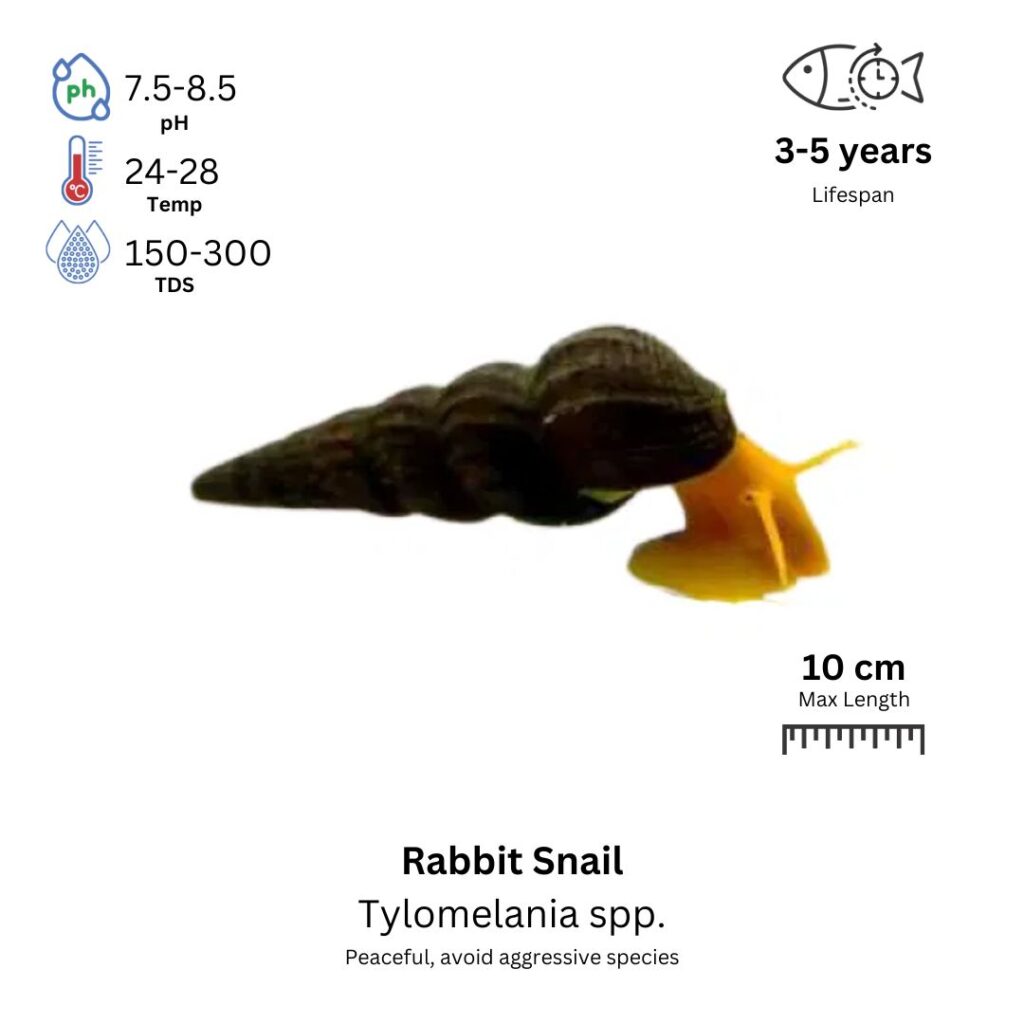Rabbit Snail
Tylomelania spp.

Description
Rabbit Snails are distinctive freshwater snails known for their unique, long, spiraled shells, which resemble the shape of rabbit ears, hence their common name. Their shells are typically brown or dark-colored, with lighter patterns running across them. The body of the Rabbit Snail is soft, often yellow to orange in color, and they are relatively large compared to other freshwater snails. These snails have a gentle, slow-moving nature and spend most of their time grazing on algae, detritus, and plant matter. Due to their interesting shape and peaceful behavior, Rabbit Snails are becoming increasingly popular in aquariums.
Habitat Origin
Rabbit Snails are native to freshwater streams and rivers in Sulawesi, Indonesia. They are often found in cool, well-oxygenated waters with dense vegetation, where they spend their time scavenging for food on the substrate.
Aquarium
Ideal Number in Aquarium: At least 3-4 individuals for social behavior.
Favorite Food

Rabbit Snails are primarily herbivores, feeding on algae, detritus, decaying plant matter, and biofilm. They will also enjoy blanched vegetables such as zucchini, spinach, or lettuce. In captivity, they can be supplemented with sinking algae wafers or specialized snail food. It’s important to ensure they have enough food to graze on to keep them healthy and active.
Behavior:
Rabbit Snails are peaceful and slow-moving creatures. They spend most of their time foraging for food on the substrate, algae, and plants. Unlike other snails, they do not reproduce prolifically, which helps keep their population in check in the aquarium. Rabbit Snails are nocturnal, meaning they are most active at night, but can also be observed during the day. They tend to hide in the substrate or amongst plants during the day, coming out in the evening to scavenge.
Special Care:
Rabbit Snails are fairly hardy but require stable water conditions, including regular water changes and clean, well-oxygenated water. It’s essential to provide them with plenty of hiding spots, such as plants or rocks, where they can feel secure. Since they are relatively slow-moving, it’s important not to overfeed them to prevent algae buildup that could pollute the water. A fine sand or smooth substrate is ideal, as their delicate antennae could be injured by sharp-edged gravel.
Compatibility with Other Fish:
Yes, Rabbit Snails are compatible with most peaceful, non-aggressive species, including small to medium-sized fish, shrimp, and other snails. They are ideal for community tanks and do not pose a threat to live plants. Avoid keeping them with large, aggressive fish or species that might disturb them, as their slow-moving nature makes them vulnerable. They are generally safe with live plants, as they graze on detritus and algae but do not damage healthy plant matter.
Breeding Tank Setup
While Rabbit Snails can breed in community aquariums, using a separate breeding tank is recommended to maximize fry survival. A 10-gallon (38 liters) tank is adequate for a few individuals, while a 20-gallon (75 liters) tank provides better conditions for larger groups. Ideal water parameters include a pH of 7.0–8.0, temperature of 24–28°C (75–82°F), and hardness of 6–12 dGH. Use fine gravel or sand substrate, and include live plants like Java moss, Anubias, and Hornwort, along with rocks and driftwood to mimic natural shelter. A gentle sponge filter ensures water cleanliness without disturbing the snails. Moderate lighting on a 12-hour light/dark cycle is sufficient.
Conditioning for Breeding
To prepare Rabbit Snails for breeding, offer a nutritious, calcium-rich diet that supports shell and egg development. This includes algae wafers, snail pellets, blanched vegetables like spinach and zucchini, and calcium supplements such as crushed eggshells or cuttlebone. Maintain good water quality by performing 20–30% weekly water changes, and simulate seasonal breeding cues by conducting a larger 50% water change and slightly increasing the temperature. This may help stimulate reproductive activity.
Spawning Behavior
Rabbit Snails are slow breeders and will typically reproduce under stable, warm conditions throughout the year. Females lay 5–10 eggs at a time, placing them on plants, rocks, or aquarium glass. These eggs are small, white, and sticky, helping them adhere to surfaces. Unlike many other aquatic species, Rabbit Snails do not require separation after spawning, as they are peaceful and do not prey on their own eggs. However, to protect eggs from other tank mates, a species-only breeding setup is beneficial.
Fry Development & Care
Rabbit Snail eggs usually hatch in 3–4 weeks at around 26°C (79°F). Warmer water may speed up hatching, while cooler temperatures slow it down. Upon hatching, fry feed on their yolk sacs, then transition to infusoria, powdered algae wafers, or crushed pellets. As they grow, offer microalgae, finely chopped vegetables, and other suitable foods. To support their growth, maintain excellent water quality through daily or alternate-day water changes (10–20%) and stable temperature.
Maturity, Identification & Stress Avoidance
Rabbit Snails reach breeding maturity at 6–12 months. Visual identification of males and females is difficult; however, females often appear larger and rounder, especially when carrying eggs. Males may be more streamlined in shape. Avoid sudden fluctuations in water conditions and overcrowding, as these can lead to stress and poor breeding outcomes. Maintain a peaceful tank and avoid aggressive fish species that might disturb or harm the snails.
